Zona Maco 2025
Mexico City, one of my new favorite cities, did not disappoint during Art Week. I was able to experience some of the best food with the best people in the best atmosphere to enjoy art. There was no shortage of art on every corner, from mosaic tiles of the early 20th century to murals and graffiti. The city was alive all hours of every day. I wanted to share the overall ambiance of the trip, as it played a big role in inspiring the type of art galleries brought to Zona Maco. Latin artists full of life and color, local scenery, unique mediums, and true masters from the region came together under one roof in an incredibly cohesive manner.
Zona Maco overshadowed the majority of the Miami Art Fairs in both curation and overall sales. Almost every booth had sales, many of them almost completely selling out. The group presentations were well thought out, with the dealers understanding the need for their biggest and brightest, but also using this to propel emerging artists onto the scene. The solo presentations took your breath away. I had to spend almost a full week just to debrief and make sense of the whirlwind that was Mexico City Art Week. With all that said, my three favorite booths were Sundaram Tagore Gallery, Swivel Gallery and Pilevneli, with honorable mention going to Homecoming Gallery, Kurimanzutto and Pace.
The way Sundaram Tagore Gallery curated its international roster of artists into such an aesthetically pleasing display should be studied. Their presentation included works by 10 artists: Miya Ando, Matthew Kirk, Karen Knorr, Chun Kwang Young, Jane Lee, Ricardo Mazal, Robert Natkin, Kenny Nguyen, Hirsoshi Senju and Zheng Lu. When I first walked by the booth, I was greeted by dark walls on the outer few sections, seamlessly transitioning into standard white walls deeper into the booth. I was immediately pulled in by a Kenny Nguyen silk tapestry on the outer wall, taunting me to see more. The dark background made the jewel-toned waves glow as if they were truly dynamic. Another piece that perfectly utilized the dark walls was a Chun Kwang Young piece that resembled a perspective on celestial bodies and outer space. The moon-like surface achieved by the pale mulberry paper, accented by colorful craters, gave it a planetary feel. Right next to it was a colorful Robert Natkin, which made me truly understand why my mentor is such a big fan. What you could call as perfect as an abstract piece can get. Sculptures by Zheng Lu right next to another Kenny Nguyen tapestry made it seem as if pieces from the metal water sculpture leaped into the painting where they now live. Accentuated by Miya Ando’s dreamy skyscapes, I wanted to put this section straight into a corner of my home.
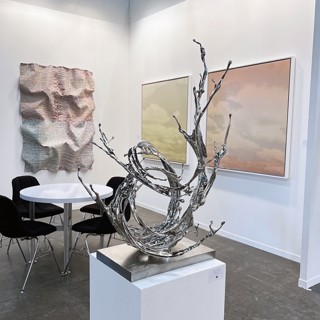
Swivel Gallery’s solo show of Rodrigo Ramirez, “Perpetually in Rot,” included nine linked paintings (A Nonatych?) and a sculpture that “represented the nine layers of the infraworld as showcased by Pre-Hispanic cultures in Mesoamerica.” When I showed a colleague the booth, their first response was, “Biblically accurate Orgasm” which, upon learning more about the works, is not too far off. The paintings depict an organic mass that has taken fluid shape, naturally achieved through the human body’s struggle to contain our intense psychological energy. Ramirez believes our minds are bound to our physical identities when in reality they would be uncontrollable. Endless possibilities of bodily representation, coming from deep within our everyday lives of contradiction. Perpetually flowing and changing shape, our physical boundaries would look like this if they showed what was in our minds. The sculpture on the ground was an incredible, abstract visualization of this mental state coming to life. I have never felt more like I was seeing into an artist's soul than with this show. The overwhelming sense of uncomfortability, yet somehow what I was seeing was human, and a feeling I could not put into words. The fact that I am still thinking about how it made me feel makes me so impressed with Swivel’s dedication to bringing Ramirez’s vision to life. The booth was shortlisted for the Erarta Foundation prize, as well as had eight of the nine paintings sold early on, and it is no secret why.
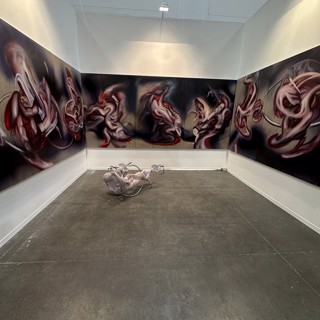
Pilevneli Gallery had, in my opinion, the largest breadth of work in terms of differing mediums and styles. With pieces from: MentalKlinik, Rasim Aksan, Nevin Aladağ, Refik Anadol, Banu Anka, Lal Batman, Ali Elmaci, Ryan Gander, Kevin Francis Gray, Serkan Sarier and Tarik Töre. Everywhere I turned was an eclectic collector’s dream house. AI generated works by Refik Anadol adorned the outer wall. Showcasing a pair of Macaws morphing seemingly naturally next to another piece that looked like fluid sloshing and forming into other things in a glass box. A giant Ali Elmaci painting of a bright-white, whimsical ghost with Javier Calleja-inspired features, juxtaposed against a fairly dark and realistic landscape with creatures fighting. As well as a sculpture (also by Elmaci) with two arms grasping a bouquet coming out of the wall, but hidden inside the bouquet is an outstretched knife, was among my two favorites at the booth. The sculptural wall piece by Nevin Aladağ was a fantastic blend of geometric design and chaos. The shapes and lines are perfect, but the overall image is not symmetrical, yet it works so well with the bright colors. Banu Anka’s pencil drawing of what I can only describe as a skater Barbie, seemingly exorcizing the life out of a human is hauntingly beautiful. I could not take my eyes off it. The transfer of life from the human to the “doll” through color is poetic and physically stunning. Last but not least, my mention of Rasim Aksan’s hyper realistic large textbook painting cannot go unnoticed. I had to do a double take, circle back around, get right up next to it, risking being warned by the gallerist of the angle I was using to look closer, to truly understand what I was looking at. This piece legitimately looks like a perfectly preserved page of a large book, that had been torn, folded, you name it. Aksan’s ability to capture shadows, and texture of what the paper would actually look like was unfathomable.
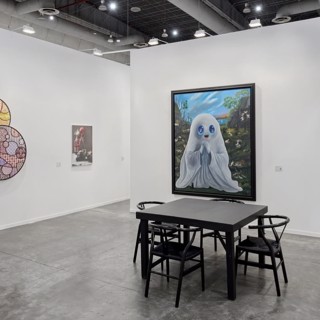
Somehow, I managed to not take a picture of every piece there, which has resulted in my “favorite” works from the fair being the remaining 200 plus pieces pictured in my phone. It would take multiple articles to truly capture everything I saw and enjoyed. Perhaps I will include pictures or videos of my favorites and just let the visuals do the talking. Homecoming Gallery’s duo show of Johnny Mae Hauser & Aldo van den Broek was worth mentioning. The pieces were made specifically for the show and truly bridge the gap between the gallery’s home country of The Netherlands and Mexico. Kurimanzutto had some truly incredible works on display. I wish I had more time to spend in their Mexico City space because I think that would have pushed them into my top three. Pace was, to no one’s surprise, a grandiose collection of artists from all over the world. James Turrell’s piece was probably my favorite here, although a large abstract painting by Marina Simao has now made my list of artists to watch. The fair, and the city were spectacular on every level. It was an experience I will never forget, and hope to have again soon. Until next time, Viva Mexico!
Written by Hutton Kalik, Gallery Director & Curator
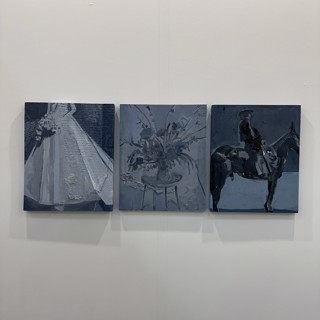
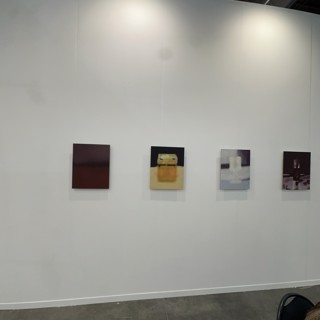
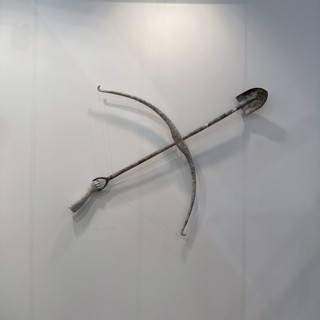
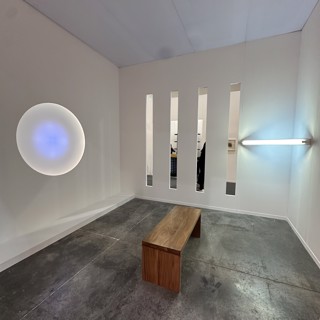
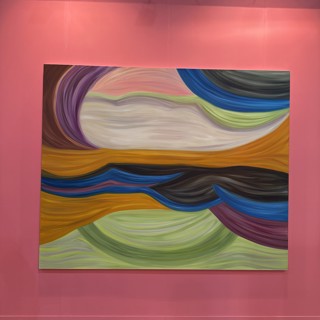
FEATURED PUBLICATIONS
ELEVATED MAGAZINES
HIDDEN GEMS: MEET REYNE HIRSCH
NFTS: NEW ART ON THE BLOCK
SPECIALIZING IN MODERN-CONTEMPORARY ART
